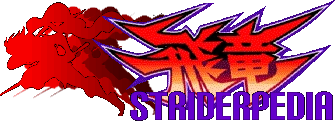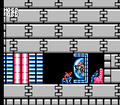Strider Hiryu is the Japanese Famicom version of Strider for the NES, which saw its release date change a number of times before being cancelled. Alleged "white cart" prototypes of this version surfaced on auction sites a number of times, and on August 2014 one of them was dumped and released online by NintendoAge user Arasoi.[1]
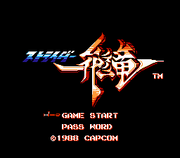
This prototype build of the NES Strider is incomplete and features a number of interesting differences when compared to the final, English version. Outside of a general code cleanup to correct performance and palette bugs, a number of alterations appear to have been made in order to reduce the difficulty for the English audience.
General differences[]
- The game's logo has the word "Strider" written in katakana instead of English.
- Title screen shows text in red instead of white, and it only features a "1988 Capcom" copyright. The English release has a 1989 copyright for Capcom U.S.A. and a "licensed by" Nintendo.
- The intro cinematic features lyrics in hiragana to go along the intro theme. These match the lyrics of the intro music as featured in Strider Hiryu: Original Music.
- Palettes in the game's cinematic introduction are slightly different. The Blue Dragon also scrolls from below instead of from above.
- Physics and movement in general are a lot more buggy and unreliable than in the released version. Some examples include Hiryu having a floatier and higher jump and looser hit detection, often overlaping with background tiles and walls. There are also a lot more palette bugs whenever Hiryu switches sections or enemies enter the screen.
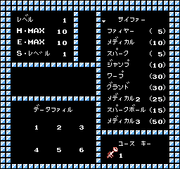
- The subscreen shows the names of all Tricks from the beginning, although they can't be selected until achieving the corresponding level up. Names are mostly the same as in the translated version, with a few exceptions: "TRICK" is "Cypher", the Tricks "SP-BALL" and the 2nd and 3rd "MEDICAL" are "Spark Ball", "Medical 2" and "Medical 3" respectively and "KEYS" is "Use Key". The subscreen on the prototype also features a double line of blue tiles on top and a line on the bottom, fully framing the whole screen unlike the English release. Finally, the music heard in the released game while accessing this screen (the same theme used in the Password screen) is not heard, and instead it retains the music from the stage Hiryu is at the moment.
- Using certain Tricks sometimes glitches Hiryu's sprites while crouching and jumping, as well as enemies and other sprites. The projectile from the "Fire" Trick sometimes comes out garbled as well.
- Hiryu's Health points are a lot lower during the first four stages: He starts the game with 10 Health points instead of 20 as in the English version. For the following level-ups Hiryu's Health increases to 12, 15 and 20 points, compared to the English version's 20, 25 and 25 respectively. After rescuing Kain, all level-ups are equal to the English version.
- Due to a glitched cutscene, however, Hiryu's second-to-last level up (after beating Los Angeles) is not calculated, so he keeps the same levels for two stages straight. Also due to this glitch, Hiryu is unable to use the Spark Ball Trick as it is never unlocked: selecting it on the select screen makes the confirm sound as normal, but it doesn't leave the screen.
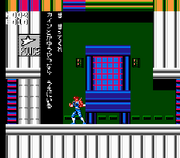
- Dialogue is presented in a black square located on the left side of the screen, and text scrolls vertically. In the English release this was changed to text being shown on a black screen, probably because English lines tend to take up more space than Japanese ones.
- All door's outside sprite appear in a two-layered design. This was reduced to a single layer in the English release, probably to avoid a bug in which one of the outer layers wouldn't open up.
- There are no special palette effects whenever Hiryu reaches one of the transition halls.
- Enemies have a brief moment of invincibility after being hit, and a number of enemies have higher Hit Points. Enemies are also less likely to drop items when killed. These changes make the Japanese prototype considerably harder than its English counterpart.
- Contact damage is overall higher, with hazards such as spikes doing a lot more damage and sending Hiryu flying higher.
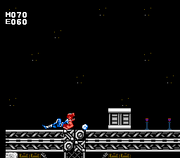
- Whenever Hiryu slips down an incline after an abrupt stop, a brief dust effect can be seen trailing behind him. The same effect is also used as a visual cue for the Attack and Aqua Boots, appearing all around Hiryu whenever he uses the Slide In or walks on water after obtaining both items. While no similar effect appears for using the Magnetic Boots, Hiryu's sprite glitches out whenever he starts walking vertically.
- Energy Capsules have a different sprite with the colors inverted. Skull Signs don't have an unique sprite, and use the capsule sprite instead.
- Some sound effects are different, certain enemies have unique sounds for being destroyed or when attacking. There are also missing sound effects heard in the released version and viceversa, like a unique sound for the pause button.
Stage differences[]
Blue Dragon[]
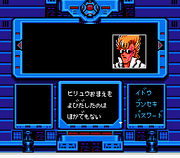
- The location of the dialogue and character mugshot is the inverse of the English release: text appears on the lower screen, while the speaker's mugshot appears on the larger, upper screen.
- Stages unlock after beating a level, analyzing files is not required.
- The cursor in the Analyze menu is a white circle instead of a blue arrow pointing down.
- "KAZAKH" on the stage select is instead "Kazakh Federation" in the prototype.
- The cursor on the map doesn't fickle while chosing a location. Some of the transport points as displayed on the map are different or wrong as well.
- The map for Egypt erroneously places it somewhere on South America.
- The map for Africa shows the stage's location being on the western coast of the continent. The English version shows its location being somewhere in Central Africa.
- There's an extra location in the map for the Strider Headquarters located somewhere in the Middle East near Turkey, which correctly warps Hiryu into the 2nd half of Los Angeles. In the English release, there are two identical transport locations leading into Los Angeles instead.
- The map for Australia shows its location slighty toward the western shore of the country, which was moved to its center in the English release.
- The Red Dragon is shown to be located around South Africa, slightly below where the spot for Africa is in the released game. There's no location shown in the English version.
- Kain's dialogue during his boss fight doesn't come out, and he goes straight to attacking.
- Sheena's cutscene doesn't properly calls her sprite, instead bringing Hiryu's sprite with a glitched palette. Her sprite set, however, can be found intact within the code.
- There are no sound effects when selecting a transport location.
Kazakh[]
- The background sky at the beginning area shows a starry night sky with no effects of any kind. The English release removed the stars and added a lightning sprite and thunder effects in the background, altering the mood entirely.
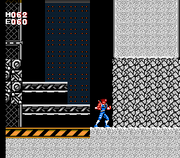
- The entrance to the Secret Police HQ and one section in the underground feature a unique sprite block, probably representing concrete, serving as an obstacle. This obstacle is unfinished, as it can be easily destroyed with a single strike and it simply disappears without any special effect, and striking the top row of blocks will glitch out the ceiling tiles and make them disappear as well.
- There's a hidden large Energy Capsule in the area where File #1 is found in the released game, with File #1 located in a different area.
- There's a small incline at the base of the magnetic wall at the back-end of the HQ, which was removed in the English version. The magnetic part on the ceiling blends in with the normal ceiling at a certain point, while in the English version the magnetic part was raised an extra layer, leaving a clear divide where the normal ceiling begins.
- After dealing with the Vice-Commander, the file falls straight in its spot instead of at the other end of the room.
- The room housing Key #4 was reworked entirely to include a Transport Tube leading down. This was done to prevent the player from having to backtrack all the way from this room to the magnetic wall and through the enemy gauntlet.
- The passage leading into the underground prison is considerably smaller in the prototype, and can only be traveled with the Slide In. This area was probably widened to avoid any possible physics bug from happening.
- The solitary cell at the leftmost area of the map has a magnetic wall next to its entrance, which was changed to a regular wall in the English version, making accessing this specific room a lot more difficult. The cell itself houses File #1 in the prototype, while in the released version it houses a hidden Skull Sign, making visiting it entirely pointless.
Egypt[]
- The Train Engine gun shoots a single, garbled projectile instead of a three-way shot.
- A small alcove above the door at the beginning of the Pyramid Base was added in the English release, to facilitate jumping into it.
- A small alcove housing a large Energy Capsule was edited and the item was removed.
- The room housing the Aqua Boots is a single room with no Transport Tube and the Boots standing on an elevation, with a scientist on the other end who explains its function. In the released game the whole room was redrawn and the scientist removed.
- There are three breakable pillars in the area before the Commander's room. The middle one was removed in the English release.
- Key #2 spawns at the other end of the room instead of close to Hiryu.
- Different enemy placement:
- In the prototype there's a Machine Cannon located next to the first area where one has to use the Triangle Jump to proceed. A 2nd Machine Cannon is also found in the small passage that leads into the 1st pillar room.
- An Armored Sentry was added in the released version at the entrance to the water canal.
Japan[]
- A single Armored Sentry spawns above the entrance to the room above Kuramoto's chambers. In the final release, this room is empty.
China[]
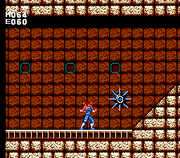
- Instead of a Robot Arm at the entrance of the right tower, there's a spiked obstacle in place performing an unique behavior: it slowly moves up and down. In the English release, they only appear as obstacles later in the stage, and only move left to right.
- The wall lights on the left tower are blue and gray instead of red and gray.
- The spiked walls are much faster than in the English version.
- The pit where the player finds the Attack Boots doesn't feature the Transport Tube seen in the released version. As this forces the player to escape by use of the Triangle Jump, the tube was likely added to provide an easier way to escape the area.
- The spiked obstacles in the room mentioned above are crudely animated in the prototype.
- Badger is not properly coded as a boss battle, so one can ignore him and continue with the stage.
- The elevator area features two platforms instead of one, which move at different directions (up and down). They are also slower, so the Turrets can actually hit Hiryu.
- Different enemy placement:
- The Robot Frong at the beginning is missing in the prototype, and there's an extra Machine Cannon in its place.
- Two Robot Arms are placed in the first room of the left tower, replaced by a Giant Robot sub-boss in the English release.
Africa[]
- The entrance to the cavern has an extra platform of leaves above it. Its removal in the English release makes it easier to enter the cavern.
- Breakable vines appear as an unique obstacles at two points during the stage, working identical to the breakable concrete walls found in Kazakh.
- Floating platforms appear with a brown/rust palette instead of being silver, although this could also be a palette glitch.
- The screen scrolls a bit further in parts that connect with the Australia-exclusive area, and one can spot Badger and Ryuzaki standing in their rooms this way.
- The set of Scuba Soldiers in the underground canal are missing, replaced in the prototype with a set of orange Robot Claws.
Los Angeles[]
- The screen doesn't fully scroll during the Kodiak battle, leaving half of his room offscreen during the boss battle.
- Faceas Clay's cutscene doesn't load up properly and no text shows up, instead an unused sprite is spawned inside the glass shield for a second, before changing into an incomplete sprite of Kuramoto. The glass shield has no hitbox and Hiryu can simply walk through it to pick up the Key and end the stage abruptly.
- There are more enemies than in the English released version:
- Two Armored Sentries spawn in the spiked wall corridor, with two extra more spawning in front of the door to Kodiak's room.
- An Egypt Soldier spawns in the spot where Sheena is supposed to appear.
- Two extra Armored Sentries spawn right before Faceas Clay's room.
Australia[]
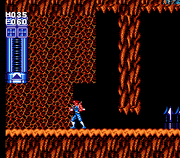
- Bird enemies appear during the first section. In the English release, this enemy is exclusive of Africa. They are also for some reason a one-hit kill enemy in this instance, draining Hiryu's entire HP if touched.
- The same vine obstacle from Africa is found here, blocking the way to the Transport Tube.
Red Dragon[]
- There's an open space next to the 2nd set of Transport Tubes. This was filled up with a wall in the English release.
- Atop the above-mentioned area stands a Scientist who warns Hiryu about a wall that can't be destroyed and must be walked around. This Scientist is removed on the English release, and replaced with Matic welcoming Hiryu from a broadcasting system.
- Flashing lights in the corridor in front of the final area are blue instead of red.
- There are no Machine Cannons in the room whose floor is made of Transport Tubes, instead there's a set of Laser Turrets in the ceiling and a red Robot Claw in the wall.
- Badger's first boss battle is missing.
- The right path leading into the large room with a spiked bed has been completely redone: in the prototype it has a blue wall and a descending shaft as the only way to continue, as well as a second incline following it; the released version has a yellow/brown wall, a drop with two platforms to the right and a Transport Tube as the only way to continue, with no incline following it. This change was likely to prevent glitches related to the Slide In and crammed spaces.
- Ryuzaki's Cypher doesn't appear on its spot above the room's exit.
- Dragon Fiend's two battle instances are instead against the unused Red Dragon boss.
- The end of the magnetic wall has an opening between the last platform and the door itself, making falling down a possibility. This was covered up in the English release, preventing any accidental falling.
- The entrance to the System next to the magnetic wall was changed: in the prototype there's a narrow passage and the Transport Tube right next to it, making it difficult to slide under it without activating the tube. In the released game, the tube was extended so it sticks outside the floor and the part making up the passage's roof was raised so as to not need the Slide to get in.
- There's a metallic contraption blocking the Transport Tube during each battle in the boss rush which explodes once the boss is defeated. Although it is obviously intended to prevent Hiryu from proceeding until the battle is won, the object has no collision and can be passed through.
- The Systems are glitched and will spawn in the wrong places, often in the middle of the ground or beneath a wall, potentially placing them in spots whre they can't be hit. Yggdrasil doesn't work properly either, and the ending cutscene and credits can't be accessed normally.
Enemy differences[]
- Three enemies have different sprites:

|

|

|
| The Russian Infantryman is entirely different to the English release's version, and uses a smaller palette of colors. | The Giant Robot has slight differences, mainly in the cockpit area and its vice grip. | The Mechanical Snail looks completely different, and curiously resembles a snail's shell much more closely as a result. |
- Sky Wing and the Armored Sentry have a different, brighter palette. Sky Wing lacks the sound effect for shooting, but has an unique sound for when destroyed instead.
- Bullets from the Machine Cannon are smaller and harder to spot.
- The Giant Robot has an incomplete behavior: it will usually spawn with his back facing Hiryu and will make no movement, allowing one to easily destroy it. If one moves in front of it, however, it will begin attacking and walking normally until he turns his back again to Hiryu.
- Scuba Soldiers don't shoot harpoons at Hiryu, and they only register damage if striking at their lower half while crouching.
- Robot Frong features an entirely different pattern: it patrols back and forth, periodically opening its eye to look in front of it. If Hiryu stands in its line of vision when it does so, the Robot Frong will become alert and throw three bombs at Hiryu, after which it turns around and resumes its pattern. In the English release, the Robot Frong never turns around at all (falling off edges if one is in its path) and activates as soon as Hiryu approaches it. Once active, it stands frozen in place as it constantly throws bombs at him. It never turns around or stops attacking, even when moved off-screen. This seems to indicate its pattern is either glitched or was altered for some reason.
- Twin Bats are destroyed in a single hit, but come in pairs of three instead of being a single set.
- The Robot Arm and red Robot Claw have glitched collision boxes, Hiryu getting damaged even if he's nowhere near them.
- Laser Turrets are a lot faster when shooting their beams.
- During his boss battle at Kazakh, Kodiak doesn't stop at the edge of the screen to turn around, instead driving all the way offscreen only to return a few seconds later.
- Flash Blade starts the battle invisible, and activates when Hiryu approaches it (usually causing him heavy damage in the process). Instead of jumping forward when close to Hiryu, Flash Blade stops in front of him and jumps upwards constantly, and to hit him one has to time the Cypher as he comes down.
- ZAIN Terminals don't shoot bombs once the square defense machine is destroyed.
- The unused Red Dragon boss is mostly non-functional: he appears, can be damaged and jumps if Hiryu jumps, but his sprite glitches out when charging up his attack (appearing, in pieces, at the top of the screen) and he freezes in place after shooting the ring of fire at Hiryu, which disappears a short distance after being thrown.
Unused graphics[]
There are a few unused graphics found in the prototype that were removed or overwritten in the final release. Note, however, that most of the unused graphics in the final can still be found in the prototype.
| Graphic | Details |

|
The same unused Russian Infantryman crouching sprite from the released version can be found in the prototype as well. |

|
Sheena's entire sprite set (including the 3rd sprite that goes unused in the English release) can be found in the game even though they are not properly called during their corresponding cutscenes. Interestingly enough, Sheena's appearance is slightly different from the released version: her hair is larger and appears to be wildly unkempt, her chest is bigger and there's a shine spot over it. The edits to her chest were possibly a request by Nintendo, who were known at the time for their strict family-friendly policies. |
| An anchor cursor and the top half of the logo for Higemaru Makaijima, both used in the game's title screen. As Higemaru was Patariro's previous released game before Strider, it is possibly the prototype was build over it. | |

|
A set of sprites of what appears to be a "DO NOT USE" message. Half of it was overwritten with other sprites in the English release. |
References[]
- ↑ Arasoi (August 2, 2014). "Strider Hiryu Prototype Release". NintendoAge forums. Accessed May 5, 2018.
| The Development of Strider | |
|---|---|
| Development sub-pages | Strider (CPS-1) • Strider (NES) • Strider (Mega Drive) • Strider II Strider (PC Engine) • Strider 2 • Strider (2014) |
| Prerelease content | Strider (CPS-1) • Strider (NES) • Strider (Mega Drive) • Strider 2 • Strider (2014) |
| Unused content | Strider (CPS-1) • Strider (PC Engine) • Strider (NES) • Strider 2 • Strider (2014) Unused enemies • Unused stages |
| Cancelled games | Strider Hiryu (Famicom prototype) • Untitled game projects • Untitled GRiN Project |
| Related | Cannon Dancer (Prerelease content • Unused content) Isuke's scenario draft |
